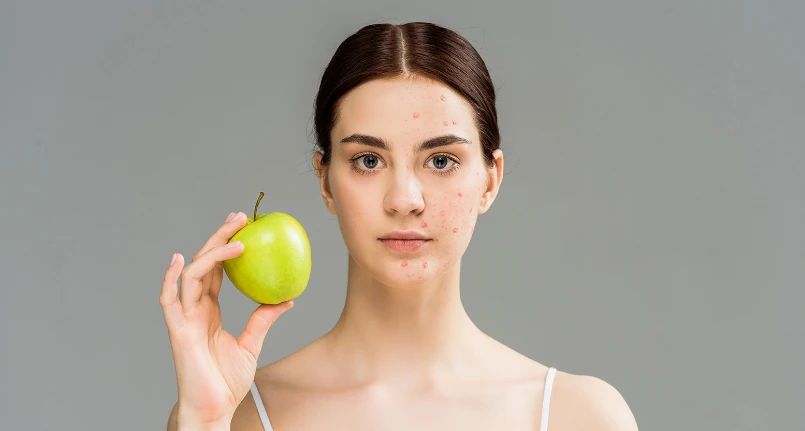Is There a Link Between Diet and Acne?
The link between diet and acne has been empirically demonstrated by many people. There are those who cover themselves with pimples when they exaggerate with chocolate , those who notice a link between acne and fatty foods such as fries , and those who consider the hated pimples the inevitable “outburst” of a recent indigestion .
Foods to Avoid
The most accredited research on the subject demonstrates that a diet rich in foods with a high glycemic index can favor the appearance of acne.
High Glycemic Index foods
When consumed in excess, sugary drinks , yogurt and fruit juices sweetened with industrial quantities of sucrose , white bread, pastry products and various sweets, raise insulin levels , which in turn increases the synthesis of IGF-1 and androgens .
These hormones stimulate the skin’s production of sebum , an oily mass that dilates the walls of the hair follicle and incorporates cellular debris until it is blocked. In addition to increasing sebaceous secretion, in fact, IGF-1 also stimulates hyperkeratization of the stratum corneum (it thickens the most superficial layer of the epidermis , accelerating its turnover).
The accumulation of sebum and debris inside the hair follicle leads to the formation of real “plugs”, called comedones ( whiteheads first and blackheads later), and favors the appearance of pimples.
The latter are caused by the activity of some skin bacteria , which feed on sebum and release free fatty acids . These substances attract white blood cells and various inflammatory molecules, giving rise to what is commonly called a furuncle.
Reducing the presence of high glycemic index foods in one’s diet therefore seems to be a valid strategy to mitigate the severity of acneic manifestations. Not only that, we’ve long known that this rule also protects against overweight, obesity , insulin resistance , type II diabetes , polycystic ovary syndrome , and coronary heart disease .
Acne and Chocolate
Of the foods thought to be responsible for acne, chocolate is probably the one most frequently implicated.
Since it is a food with a high glycemic index and load , it is clear that an abuse of chocolate can favor the appearance of acne and pimples.
However, to clarify the role of this food in the acne diet, it is important to consider the quality of the chocolate consumed.
- If we take commercial chocolate spreads as a reference (see Nutella ), they are on average foods with a high glycemic index and load (because they are very rich in sugars), with high percentages of saturated fat from palm oil . Often there are also milk derivatives and their particularly sweet and inviting taste often leads to consuming them in excess. These poor quality products can therefore be considered the ideal prototype of pro-acne food.
- The situation is different for extra-dark chocolate bars with high cocoa percentages (70% and more), in which the content of simple sugars is lower and where tropical oils are not normally found . Furthermore, the bitter taste tends to limit the consumption portions. Therefore, accustoming the palate to this category of products while avoiding the commercial ones can be a valid aid in the diet against acne. Alternatively, it is also possible to prepare spreadable creams at home with quality ingredients, following our video recipes:
- Spreadable Cream with Nutella type Hazelnuts
- Chocolate Spread Without Eggs
- Vegan Hazelnut Spreadable Cream
Anti-Acne Foods
If we had to draw up a specific diet against acne we would therefore have to repeat the basic principles of a healthy diet in detail. Therefore, it is important:
- contrasting a low intake of refined carbohydrates with the right quantities of fats , proteins , complex carbohydrates and above all fibres , mineral salts and vitamins ,
- rediscover fish and legumes on at least a couple of weekly occasions each
- limit salt and alcohol
- at the same time increase the intake of vegetable foods ( fruit and vegetables ) arriving at consuming at least 4-5 portions a day.
A diet of this type provides numerous functional substances ( phytocomplexes ), which act harmoniously in regulating biological functions and eliminate any need to resort to various supplements .
Supplements against Acne
Among these there are products specially designed for acne, the composition of which – in the absence of a universally effective remedy – is the most variable.
In general, we try to act on several fronts, adding various substances to the diet, such as:
- antioxidants ;
- vitamins (especially A , E , C and pantothenic acid);
- fibers and probiotics to regulate intestinal function;
- zinc ;
- liver detoxifiers ( boldo , artichoke , milk thistle );
- plant extracts with antiandrogenic properties ( Serenoa repens , pumpkin seeds , African pigeon) for man;
- phytoestrogens for women.
Other articles on ‘Diet and Acne’
- Homeopathy acne
- Acne
- Acne: Acne medications and treatments
- Acne – Medicines for the treatment of Acne
- Acne: natural remedies




